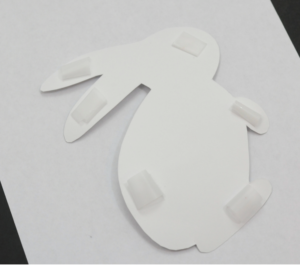Painting is such great fun for children, and an essential activity for the early years. Finger painting is wonderful for the young, as it feels good, is easier than having to handle a paintbrush, and is a good sensory activity.
When I was young, I loved doing crafts, and I find many children do, but their main benefit as far as learning is writing, because it works with fine motor skills, scissor skills, and other skills we practice during writing.
Try doing this activity outside for a little fresh air!
Best Ages for This Activity
This activity is great for 1 to 3-year-old children, but feel free to try if your child would enjoy it, regardless of their age.
How to Make It
Supplies
- White paper
- Washable paint Washable paint or Finger paint
- The silhouette of a rabbit, or “bunny” which you can download here
- A paper plate or other washable container to put some paint in
- Tape to hold the bunny silhouette in place
- Scissors for your child (or you if your child is too little) to cut the bunny silhouette for them
Optional Supplies
- A printer – you can always draw and cut out your own bunny silhouette, bypassing the need for a printer
- One cotton ball for the tail
- Glue to glue the cotton tail
Prepare
- Make sure your child is in clothes you can wash the paint off
- Print or draw the bunny silhouette from the template provided above
- Cut around the silhouette
- Tape the bunny silhouette to the centre of a sheet of paper

- Place the sheet of paper on a wipeable surface (a table is fine)
- Put some paint on a paper plate or container your child can dip their fingers in
- Describe the activity to your child
- Have fun!
- Once your child puts their fingerprints all over the sheet, let it dry and carefully remove the taped-on bunny silhouette so you are left with your final painting.
Learning Opportunities
Children will learn to use finger paint and make an art piece with it. They will feel the paint on the tip of their fingers, a nice sensory activity. They will also use their fine motor skills by cutting and by making fingerprints of the same proportion. Fine motor skills are critical for writing. They will learn about math by trying to space out their fingerprints evenly, and by making “circles” with their fingers.
Extended Learning Opportunities
- Learn about rabbits with your child
- Visit a farm or petting zoo to see where and how rabbits live, feed them, and learn more about them, hands-on
- Watch a child-friendly video to learn more about rabbits, like this one
- Learn how to draw a rabbit (or several) with your child. I prepared a document you can access here, with different styles of drawing rabbits (including some classics) where you and your child can discuss the different styles they like, the details, the paintings versus drawings, and so much more – enriching your child’s vocabulary while learning about drawing and illustration. This exercise is an immense opportunity to discuss, elaborate, exchange ideas, thus enriching your child’s vocabulary.
- Make a book of rabbits with your child: use a beautiful but inexpensive notebook with blank pages like this one
- Help your child write the title (or write it for them if they are too young), draw a photo and write their names as authors of the book (ex: Bunnies by Emily Jones). Inside, you can paste photos of rabbits cut out from magazines (I prepared a document you can access here with some photos I found myself that you can print and cut out). You can also have your child’s drawings of bunnies, a photo of the finger painting, and of your child working on the painting, and you can also help your child write the things they learned about rabbits, or the things they want to remember.
- Once the book is done, display it proudly in your child’s library. Your child just wrote their first book! Watch as your child picks up their book time and again, and relives all the learning you did together, adding as they go along. According to the Reggio Emilia early learning philosophy, documentation is an essential step in your child’s learning, and by helping your child document what they learned in this book, you did exactly that.
Things to Keep in Mind
Please keep in mind that young children need adult supervision at all times. Although you can use non-toxic paint, it is still best not to ingest.
Books You Might Like
Click the images below to see where you can buy these products.
Books for babies to 3-year old’s
Books for 3 to 5-year old’s
Toys for Any Age
Toys for 0 – 18 months old
Toys for 1 to 3-year old’s























